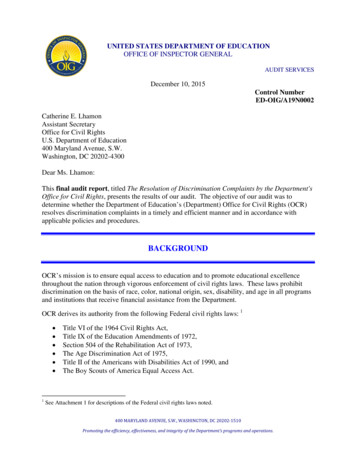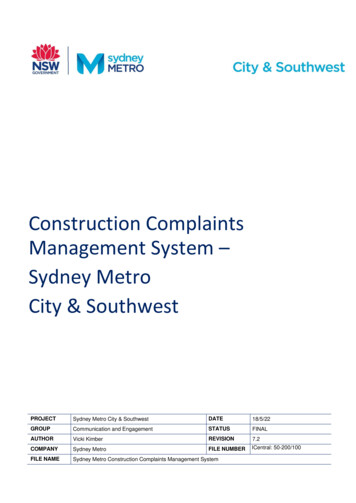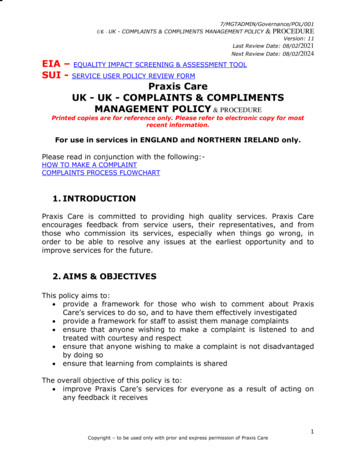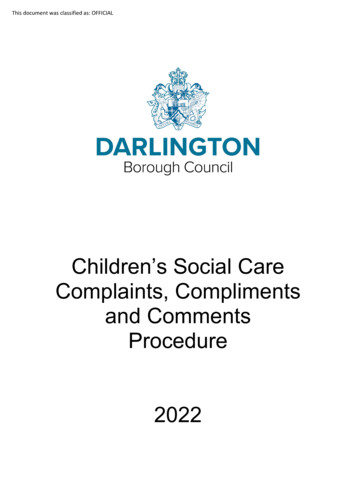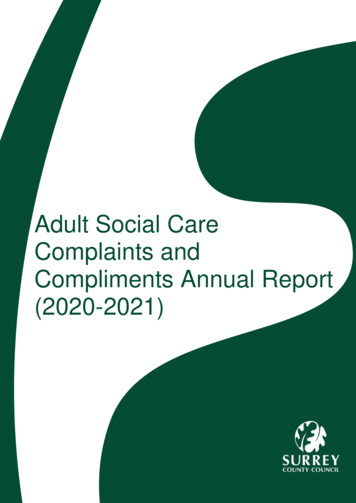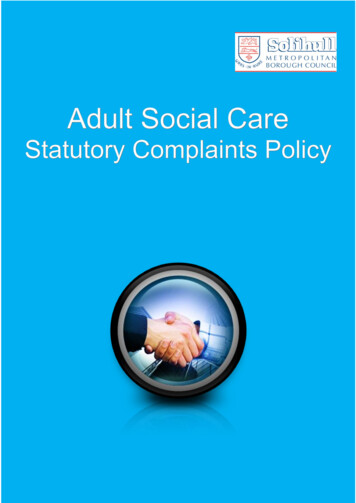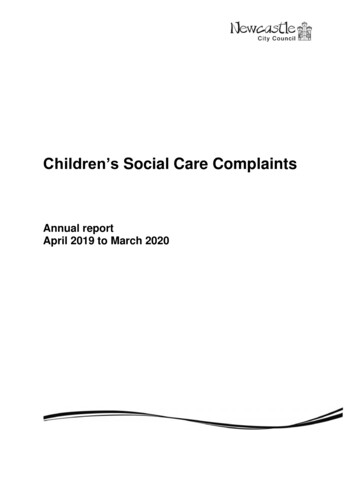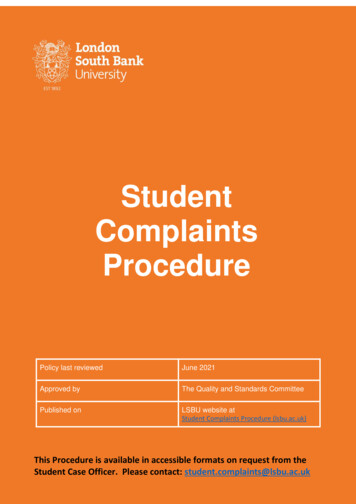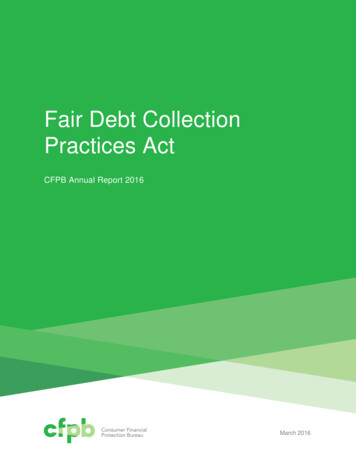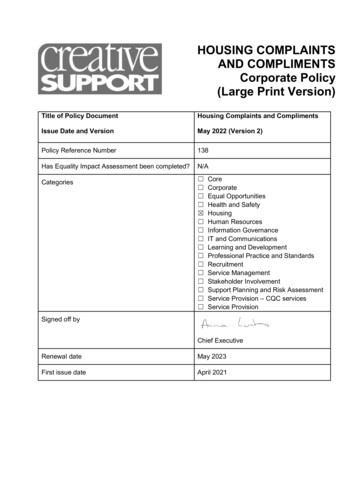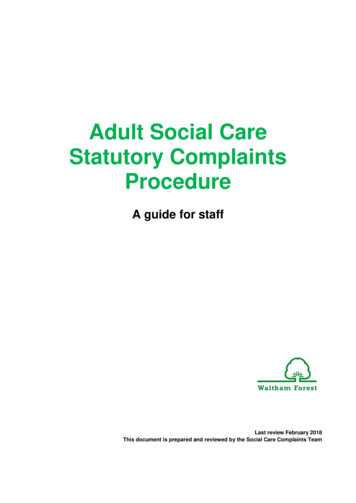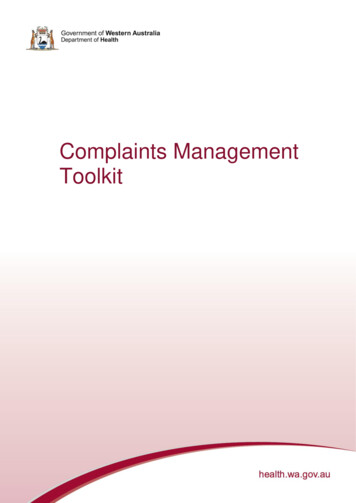
Transcription
Complaints ManagementToolkit
ContentsIntroduction3Frontline complaint management4Investigation4Plan investigation4Conducting staff interviews4Analysis and review5Recording complaint information6Suggested Reporting Fields – Complainant and Consumer6Suggested Reporting Fields – Provider7Reporting7Sample forms and checklists8Example form 1: Frontline Staff Complaint Management8Example form 2: Health Service Complaint Form9Example form 3: Complaint Management Record Form11Example form 4: Investigation Checklist15Example form 5: Complaint Evaluation Survey Form17Sample letters19Example letter 1: Acknowledgement of Complaint19Example letter 2: Advice about Complaint Resolution Delay20Example letter 3: Confirmation about Complaint Resolution21Example letter 4: Response to Vexatious Complaints22Example letter 5: Response to Complainant Where Complaint Included Allegations ofMisconduct24Appendix 1: Data definitions25Complaints25Complaint issues26Complaint resolution rate27References292
IntroductionThe Complaints Management Toolkit (the Toolkit) aims to assist WA health system staff inundertaking efficient complaints management processes. These processes are outlined in theComplaints Management Policy1 (2019) and the Complaints Management Guideline2 (2019).The complaint management process consists of the following key steps:1. Frontline complaint management: Frontline staff should manage complaints by eitherresolving the complaint or escalating the complaint to relevant staff.2. Acknowledgement: An acknowledgement must be provided to the complainant within fiveworking days from receipt of the complaint.3. Assessment: Determine risk profile (safety, legal, political, media and/or financial risk),appropriate officer/agency notification and scope of investigation.4. Investigation: Actions to assess and resolve complaints are taken by appropriate officers(investigation, analysis, consideration of recommendations for resolution).5. Response: A response must be provided to the complainant within 30 working days. If thecomplaint is pending, feedback to the complainant must be provided at 15 days intervals. Ifthe complaint cannot be resolved internally it is to be referred to an external agency.6. Recording and reporting: Complaints are recorded and registered on a centralregister/database. Complaints data is regularly analysed and reported upon to identifycomplaint trends and areas for improvement.7. Service Improvement: Quality improvement activities to address systemic and recurringissues are identified, initiated and evaluated.This toolkit focuses on the management and reporting of complaints. Specifically this includesfront line complaint management, complaint investigation and the recording and reporting ofcomplaints. Refer to the Complaints Management1 policy and the Complaints ManagementGuideline2 for further information on the above steps.3
Frontline complaint managementMany complaints are straightforward and can be resolved by frontline staff. Managingcomplaints when they arise can often avoid the complaint being escalated. Staff should beaware of their role in complaints management and be supported to perform this function. Asample checklist ‘Frontline Staff Complaint Management’ is provided in the ‘Sample forms andchecklists’ section of this Toolkit. This checklist can be used or adopted by Health ServiceProviders to provide to staff and/or make visible in staff areas.InvestigationThe investigation of a complaint relating to health care services will offer the opportunity todetermine what occurred to whom and how; and, identify how things might be, or should be,done better in the future.Not all complaints require an in-depth investigation. The level of investigation required will bedetermined by the relevant manager and based on an objective review of the informationavailable.A written record of the information gathered and any decisions made must be maintained.Plan investigationComplaints should be investigated in accordance with the severity assessment made (i.e.Seriousness Assessment Matrix (SAM) score), with those meeting the criteria for a high toextreme risk profile given priority over those with low to medium risk rating. If appropriate,immediate remedial steps should be taken to address a risk to the safety of a consumer(s).Where a complaint identifies a clinical risk, Health Service Providers should verify whether ornot the risk is already logged in the Enterprise Risk Management System (ERMS). When anidentified clinical risk is not already logged in the ERMS, this should be undertaken in line withlocal processes. Refer to the Complaints Management Guideline2 for further information on risk.To determine the information that is required for a complaint investigation: Review information provided by the complainantDetermine whether the investigation needs to focus on one particular issue, or all issuesAscertain whether consumer consent is required for an investigationIdentify the information required to establish the facts:o Consumer’s medical recordo Procedure / guidelines / protocolso Relevant policyo Staff rosterso The staff involved in each issue and those whom you will need to interview.Conducting staff interviewsStaff should be notified (preferably in writing) about the complaint and issues involved and beinformed of their rights in terms of having a support person present at the interview. They maywant to seek supervision/managerial, professional or legal support depending on the gravity ofthe issue(s).Prior to the interviews taking place, interviewers should prepare an outline of factual issue(s)and other key questions about the incident that the staff member may be able to address.Interviewers should explain the purpose of the interview and that notes will be taken of answersthat are provided.4
At the end of the interview key points should be reviewed and summarised. Where appropriate,those involved in the interview can be provided with a written summary of the discussion toreview and provide their agreement that the written summary accurately reflects the discussion.Advise the interviewee of the process, what will happen next and invite them to address anyquestions to you for response. If a statement has been prepared this should be signed by theinterviewee. If a statement will be drafted at a later stage, ensure the interviewee understandsthat they will be provided with a draft, for any amendments and their signature, prior to thestatement being finalised.Analysis and reviewInformation should be evaluated, which could include an assessment of the following: Can the version of events described by a person be independently verified?Are there inconsistencies in information provided by interviewee(s)?Did the staff member have direct knowledge of the event/incident? – Did they see or hearit themselves? (Direct knowledge is more credible than indirect)Does the staff member have a personal interest in the outcome? (Evidence is morecredible if it comes from a person who does not have a personal interest in the outcomeof the matter)Is there sufficient information to determine whether particular standards have been met?After considering each piece of evidence in terms of relevance and credibility, consider allrelevant evidence together. While one piece of evidence alone may not appear to support theallegation, it may appear stronger when supported by other evidence. At all times theinvestigator must act without bias. With all the necessary information an assessment of itsvalidity and contributing factors should be identified.For the purpose of identifying trends over time and assisting with implementing systemimprovement/changes, quantify contributing factors such as:BarriersResource issuesInadequate type of expertiseWorkload issuesInexperienceFatigueInadequate equipmentCompeting restrictionsPolicy/procedure/protocol/guidelines not followedCommunication issuesHealth literacyInadequate consumer/carerengagementImpaired cognitionInadequate policy/procedureInadequate staffingRosteringEnvironmental factorsServices not culturallyappropriateInadequate training and/oreducationConsumer disabilityOther significant issuesOnce contributing factors have been considered and any complaint trends identified,recommendations for service improvement(s) should be made and a response provided to thecomplainant.5
Recording complaint informationIt is important for an effective complaint management process to identify the subject of acomplaint, assess the potential risks and subsequently its appropriate investigation scope bygathering and documenting sufficient information. Therefore, comprehensively recording anddocumenting information is essential.Suggested Reporting Fields – Complainant and ConsumerFieldConsumerComplainantNameDate of birthGenderContact details CommentAddress, phone, email and contactpreferences Relationship to consumerRecord/patient number Interpreter requiredCountry of birthPreferred language Aboriginal and/or TorresStrait IslanderAdmission status Date of complaintDate of incidentLocation of incidentAuthorisation to releaseinformation Complaint information is confidentialand is not to be filed in the medicalrecord, though the consumer’s UMRNmay be necessary if the complaintneeds to be investigated as a clinicalincident Refers to the main language other thanEnglish spoken at homeInpatient, involuntary, outpatient,community patient, veteran, visitor,public, private, other, not relevant Required and/or provided6
Suggested Reporting Fields – ProviderFieldProviderName of service How complaint was lodged Consumer objectiveSummary of complaintStaff involved Categorisation of complaint issues Risk Profile/Score Action/s takenOutcome / resolution CommentVia telephone, online, in writing, inpersonDesignationSee the Complaints ManagementGuideline2 section on complaintcategorisation, definitions andexamplesSee the Complaints ManagementGuideline2 section on theSeriousness Assessment MatrixReportingThe Patient Safety Surveillance Unit (PSSU) oversees the monitoring, reporting andmanagement of complaints information at a state level. Complaints data must be provided to the(PSSU) within the Patient Safety and Clinical Quality division, Department of Health as outlinedin the Complaints Management Policy1.Under the Health and Disability Services (Complaints) Act 19954 and the Health and DisabilityServices (Complaints) Regulations 20103 Health Service Providers are legislated to provideinformation relating to complaints received by the Health Service Provider, and action taken, tothe Health and Disability Services Complaints Office on an annual basis. Refer to theComplaints Management Guideline2 for more information on the Health and Disability ServicesComplaints Office reporting requirements.For any enquiries s,contactthePSSUat7
Sample forms and checklistsThe following forms and checklists may be used or adapted to aid in the management of acomplaint. It is recommended that feedback forms which are provided to consumers and carersbe accessible and appropriate, and where possible, translated into other languages.Example form 1: Frontline Staff Complaint ManagementReceive complaint Actively listen – often individuals simply wish to voice their concerns and have someone listenClarify the key concern(s) of the complaint - ask questions to ensure you understand thecomplaint Determine desired outcome including suggestions on how to improve health care services Identify if there are any immediate issues arising from the complaint and respond to them asappropriateManage complaintResolve: If the complaint can be resolved at the point of contact do so, including offering a remedyappropriate to the complaint and your position Record feedback into the Datix Consumer Feedback Module (CFM) to aid in identifyingcomplaint themesEscalate: Complaints should be escalated to a Complaints Handling Officer or senior staff member whenthe consumer (or their representative) wishes to lodge a complaint and/or the complaintissue(s) is complex or beyond the scope of your position Advise the consumer (or their representative) of the complaints management process and thatthey will be contacted by a Complaints Handling Officer or senior staff member who will followup their complaint. Determine the complainant’s contact preference. Record all complaints in the Datix Consumer Feedback Module (CFM) for complaintmanagement, data collection and analysisReflect on complaintService Improvement: Consider if this is an isolated incident or is recurring Identify any necessary changes to processes or systems Implement identified changes as appropriate or share quality improvement strategy with a moresenior staff memberTips for managing difficult complaint situations Remain calm, considerate and empatheticFocus on the issue(s) rather than the personAllow them time to voice their concernsListen to what they are saying – they mayhave a valid point and simply want someoneto listen Use neutral tone and languageLet them know what you can do to helpApologise that their experience was below theirexpectationsAsk a colleague or more senior staff memberfor assistance8
Example form 2: Health Service Complaint FormFeedback form(Add your logo here)Complainant detailsConsumer details (if different)Name:Name:Relationship to patient/consumer:Address:Address:Post code:Post code:Phone number:Email:Contact preference:Date of Birth:Gender:MaleFemaleOtherDo you identify as Aboriginal and/or Torres StraitIslander?NoYes, AboriginalYes, Torres Strait IslanderYes, both Aboriginal and Torres Strait IslanderPhone number:Email:Contact preference:Date of Birth:Gender:MaleFemaleOtherDoes the consumer identify as Aboriginal and/orTorres Strait Islander?NoYes, AboriginalYes, Torres Strait IslanderYes, both Aboriginal and Torres Strait IslanderCountry of birth:Country of birth:Interpreter needed:NoYesInterpreter needed:NoYesLanguage spoken at home:Language spoken at home:Do you have a disability:NoYesPlease describe:Does the consumer have a disability:NoYesPlease describe:Complaint detailsDate of complaint:Date of incident:Location of incident:9
Summary of complaint (What happened? Who was involved?)What would you like to happen as a result of this complaint? What would be a satisfactoryoutcome?Please let us know how we could improve our serviceFor Health Service Provider use:Admission rVoluntaryInvoluntaryHow was the complaint made:LetterFeedback formTelephoneEmailFace to facePatient OpinionOtherWho took the complaint?Name:Work location:Contact number:Signature:Date:Thank you for your feedback10
Example form 3: Complaint Management Record Form(Add your logo here)Complaint Management Record FormInitial receipt of complaintDate of receipt:Ref. No.:UMRN:How was the complaint received?LetterPhonePatient OpinionOtherEmailIn PersonFeedback FormWho took the complaint?Name:Signature:Contact number:Work location:Complainant detailsConsumer details (if different)Name:Name:Relationship to consumer:Address:Address:Post code:Post code:Home phone:Mobile:Contact inal and/or Torres Strait Islander:NoYes, AboriginalYes, Torres Strait IslanderYes, both Aboriginal and Torres Strait IslanderNot statedCountry of birth:Home phone:Mobile:Contact inal and/or Torres Strait Islander:NoYes, AboriginalYes, Torres Strait IslanderYes, both Aboriginal and Torres Strait IslanderNot statedCountry of birth:Interpreter needed:YesNoPreferred language / language spoken at home:Interpreter needed:YesNoPreferred language / language spoken at home:Disability:YesNoType of disability:Disability:YesNoType of disability:Complaint detailsDate of complaint:Location of incident:Date of incident:Was the consumer receiving mental healthservices?11
Summary of complaint (What happened when? Who was involved?)Categories of complaint: Sub-category issues1. Access2. Communication3. Decision making4. Quality of clinical care5. Costs8. Rights, respect anddignity7. Grievances8. Corporate services9. Professional conduct10. Carers CharterInitial complaint risk assessmentInitial risk ratinga:Risk preexisting in ERMSb:SAM 1YesSAM 2NoSAM 3Not applicableSAM 4Comments:Risk added to ERMS:YesNoNot applicableSummary of InvestigationabRefer to the WA Complaints Management Guideline to view risk assessment tablesEnterprise Risk Management System12
Confirmed (post investigation) risk assessmentConfirmed risk rating:Risk preexisting in ERMS:SAM 1YesSAM 2NoSAM 3Not applicableSAM 4Comments:Consumer objectiveAccess to serviceReceive an apologyChange practice/procedure/policyObtain refund/ compensationReceive an explanationRegister concernResponsibility acknowledgedResolve adverse outcomeOtherRisk added to ERMS:YesNoNot applicableOutcome/ Resolution for the complaintConcern registeredService providedApology providedChange of practice/procedure/policy effectedCosts refunded/compensation providedExplanation providedConcern registeredResponsibility acknowledgedComplaint withdrawnOtherRecommendations/ Action takenQuality improvement activity including risk management initiatives and system wide changesPolicy and/or procedure written or modifiedTraining/education of staff providedStaff member/contractor counselled and offered performance supportStaff duties changedFormal warning givenFormal warning documented on personnel recordRelevant registration board notifiedNo further action requiredOther, please describe:System improvement - Quality improvement initiated as a result of this complaint13
Activity LogActionComplaint receivedComplaint registered in central databaseInitial SAM score recorded in central databaseVerified if risk recorded in ERMSConsumer consent acquiredAcknowledgement of complaintInvestigation commencedConfirmed SAM score recorded in central databaseFinal response provided to complainantUpdate sent to complainantResolution entered in central databaseComplainant referred to external agencyReported to Chief Executive/ Co-Director/EDSignatureDateThis form must not be filed in the patient’s medical record14
Example form 4: Investigation Checklist(Add your logo here)Complaint Management Record FormContact the complainant to: Thank them for their feedbackClarify the key concerns of the complaintObtain any additional information to fully understand the complaintDetermine any immediate issues arising from the complaint and respond to them asappropriate Identify desired outcome including suggestions on how to improve health care services Determine if the complainant has any supporting documentation or witnesses Determine the complainant’s preference for a particular mode of communication (includingface-to-face, written, telephone, email) Offer assistance if the complainant requires support (e.g. due to language difficulties, hearingor sight impairments, need for a support person, translator or advocate)Manage the complaint:Acknowledgement: Register complaint and document significant actions during the investigation. Documents mustbe filed separately to the medical record Provide information to the complainant about the investigation process and anticipatedtimeframes within 5 working daysAssessment: Has the complaint been previously dealt with, or should it also be dealt with under any otherpolicy (e.g. Clinical Incident Management Policy)? Does the complaint raise issues of possible staff misconduct and thus need to managed inaccordance with relevant local processes and WA health system policies (e.g. NotifyingMisconduct Policy)? Is media attention possible? If so, should the matter be referred to a higher level in theorganisation? Does the complaint carry clinical risk and need to be logged in the Enterprise RiskManagement System (ERMS)? Is legal action possible? Seek legal advice as required Are there any immediate safety issues that need to be addressed? Does the complaint contain details about a clinical incident that may require notification (inaccordance with the Clinical Incident Management Policy)? Analyse the complaint to identify issues, pertinent sources of information including policies andguidelines, and the relevant partiesInvestigation: Develop a strategy and framework to guide the investigation noting the requirement to updatethe complainant every 15 working days after the initial 30 working days Assign a suitable investigator. Does the investigator have sufficient experience and/orqualifications? Does the investigator have any conflicts of interest? Prepare for and then conduct interviews with involved persons15
Gather hard copy and electronic information - interviews, reports, medical records, policies andguidelines or other relevant documentationAssess the accumulated information. Identify gaps, inconsistencies or ambiguities in theinformation. Consult clinical/professional advice as requiredSeek corroborative evidence if conflicts arise in information obtainedIf the complaint identifies a significant clinical risk and/or systemic issues, utilise systemicinvestigative methodologies such as root cause analysisEnsure requirements of procedural fairness are met. Was the respondent/interviewee(s) givensufficient details of the complaint? Was the respondent given an opportunity to respond to thecomplaint? Was the respondent informed of any adverse proposed actions and the grounds forthese? Were submissions made by the respondent duly considered?Prepare an investigation report noting information obtained and recommendations for anycorrective actionAssign and record the post investigation SAM scoreResponse: Generate and explore options for resolution, consistent with the complainant’s desiredoutcomes (if possible) and consistent with organisational objectives/policies where appropriate Advise relevant parties of the outcome(s) within 30 daysService Improvement: Investigate extent of problem within the service Identify quality improvement activities and communicate these within the service as required16
Example form 5: Complaint Evaluation Survey FormConsumer feedback about the complaints management process is important to identifyopportunities for improvement in the complaints management process from a consumer’sperspective. It also helps the service gauge the consumer’s expectations for complaintresolution and the degree to which these have been met.When seeking consumer feedback it is important to use a variety of mechanisms to ensurefeedback is able to be obtained from a variety of consumer groups. Survey results are one wayto receive consumer input to review and improve strategies for enabling consumer engagement,particularly in terms of accessibility, accountability and responsiveness.Dear Consumer,Thank you for taking the time to provide feedback to [insert name of service]. In order to improve ourcomplaints management processes we would appreciate your feedback about how your complaint wasmanaged.Any feedback you provide is strictly anonymous. You are under no obligation to complete thissurvey.Please or circle your responseComplaint SurveyQ1. My complaint was taken seriously1Not seriously2345Very seriously2345Very respectfully345Very satisfiedQ2. I was treated with respect1Very disrespectfullyQ3. I was satisfied with the information given1Very dissatisfied2Q4. Were you given the name and phone number of aperson to contact for information? YesQ5. Did you need additional help in making yourcomplaint (e.g. interpreter, support person) No Yes NoQ6. If you answered yes in Q5, were you satisfied with the help given? Yes NoDo you have any comments about the help that you were given?17
Q7. My complaint was treated in a confidential manner Yes No YesQ9. I did not suffer any negative impact from making acomplaint YesQ8. I was kept up to date on the progress of my complaint NoQ10. I got what I expected by raising my concern No Yes NoQ11. How did you know about the complaints process? I saw posters or brochures in the buildingI read some patient informationI found the information on the internetI was made aware of the complaints process by a staff memberI asked a staff member how I could raise a complaintI saw the customer liaison office/officerI was already aware of the complaints processQ. Do you have any further comments or suggestions that would help us in improving our complaintsmanagement service?Thank you for your time and feedback.Please return to [insert name of service] in the enclosed prepaid envelope.18
Sample lettersCommunication with consumers about the complaints management process should be openand transparent with informative and timely updates about the status of the process.Example letter 1: Acknowledgement of ComplaintIn accordance with the Complaints Management1 policy, complaints must be acknowledgedwithin five working days following the Health Service Provider’s receipt of the complaint.[Insert name and address]Dear [insert Mr/Mrs/Ms/Dr Surname]Thank you for your letter dated [insert date] concerning [insert summary of letter]. We are writing toacknowledge receipt of your correspondence.The Chairperson/Director and staff of the appropriate department will investigate the matter/s you haveraised and the information provided will be reviewed by the [insert title of relevant person]. Alldocumentation related to the investigation of your concerns will be treated in a confidential manner andaccessed only by staff directly involved in the investigation.In accordance with the WA health system’s Complaints Management policy, this process should becompleted within 30 working days. If there are any delays, you will be contacted and informed of theprogress in 15 day intervals.We are always striving to improve our services at [insert name of service], so thank you for bringing thismatter to our attention. Please do not hesitate to contact us on the number listed below if you have anyfurther queries.Yours sincerely[Insert name and contact details]19
Example letter 2: Advice about Complaint Resolution DelayIn accordance with the Complaints Management1 policy, complaints must be resolved within 30working days following the Health Service Provider’s receipt of the complaint. If a resolution ispending, Health Service Providers are required to provide the complainant with progressupdates at 15 working day intervals, with the first update falling due 30 working days followingreceipt of the complaint.[Insert name and address]Dear [insert Mr/Mrs/Ms/Dr Surname]Thank you for your feedback dated [insert date] concerning [insert summary of letter]. It is importantthat we get feedback about our service, so I appreciate that you took the time and effort to let meknow about your experience.In accordance with the WA health system’s Complaints Management policy, complaints should beresolved within 30 days following their receipt. I am writing to you to inform you that due to [insertreasoning for delay] there has been a delay resolving this issue.To date we have [insert progress summary].I am hoping to come back to you as soon as possible with a complete response. Please do nothesitate to contact me at any time if you have further questions with regard to the complaintmanagement process.Thank you again for bringing your concerns to my attention as we rely on feedback such as yours toimprove the service we provide.Yours sincerely[Insert name and contact details]20
Example letter 3: Confirmation about Complaint ResolutionIn accordance with the Complaints Management1 policy, complaints must be resolved within 30working days following their receipt by the Health Service Provider.[Insert name and address]Dear [insert Mr/Mrs/Ms/Dr Surname]Thank you for sharing your health care experience with [insert name of service]. It is important thatwe get feedback about our service, so I appreciate that you took the time and effort to let us knowabout your experience.In relation to [insert complaint issue(s)], [insert name of service] investigated the incident and basedon the information you provided and what we discovered throughout the investigation, [insertconclusions and actions taken].On behalf of [insert service name] I would like to express my regret that the health care that wasprovided to you [or insert appropriate person] did not meet your expectations.Thank you once again for bringing this issue to the attention of [insert service name]. If you believethat these issues have not been adequately attended to, please know that you may pursue thismatter with the Health and Disability Services Complaints Office (HaDSCO). HaDSCO are anexternal and independent agency who provide a free impartial resolution service for complaintsrelating to any health or disability service in WA. HaDSCO can be contacted on 08 6551 7600 or atmail@hadsco.wa.gov.auYours sincerely[Insert name and contact details]21
Example letter 4: Response to Vexatious ComplaintsComplainants are deemed to be vexatious when they harass, annoy, cause delay or causedetriment rather than genuinely intend to resolve the complaint. They also include complaintswhich are instituted or pursued without reasonable grounds.It is important that decisions to restrict access should occur with the following considerations: It should be a measure of last resort and should only be utilised if the complainantcannot be satisfied with the outcome of the complaint despite all efforts being made bythe service;The decision to restrict access should be approved by an appropriate senior staffmember;All decisions, actions and correspondence should be documented thoroughly; andAll actions taken to address the complaint should be communicated with the complainant.Services should be mindful that the complainant may decide to share this letter with externalagencies
The Complaints Management Toolkit (the Toolkit) aims to assist WA health system staff in undertaking efficient complaints management processes. These processes are outlined in the Complaints Management Policy1 (2019) and the Complaints Management Guideline2 (2019). The complaint management process consists of the following key steps: 1.
